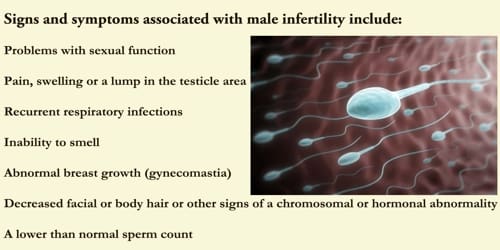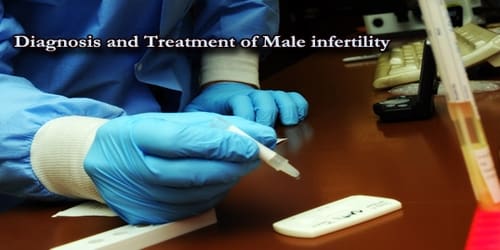Male Infertility (Symptoms, Diagnosis, Treatment, and Prevention)
Definition: Male infertility is due to low sperm production, abnormal sperm function or blockages that prevent the delivery of sperm. Illnesses, injuries, chronic health problems, lifestyle choices, and other factors can play a role in causing male infertility. In humans, it accounts for 40–50% of infertility. It affects approximately 7% of all men.
According to the World Health Organization and the International Committee Monitoring Assisted Reproductive Technologies (ICMART), failure to conceive is defined as clinical infertility if pregnancy is not achieved after 12 months or more of regular unprotected sexual intercourse.
Infertility is a widespread problem. For about one in five infertile couples, the problem lies solely in the male partner. It is estimated that one in 20 men has some kind of fertility problem with low numbers of sperm in his ejaculate. However, only about one in every 100 men has no sperm in his ejaculate.
Male infertility is more common in environments with high levels of environmental pollution, including water contaminants, pesticides, and herbicides. Some recent population studies have shown that sperm counts have been declining universally even though infertility has not been increasing substantially. It is diagnosed when, after testing both partners, reproductive problems have been found in the male.
Signs and Symptoms of Male infertility: In most cases, there are no obvious signs of infertility. Intercourse, erections, and ejaculation will usually happen without difficulty. The main sign of male infertility is the inability to conceive a child. There may be no other obvious signs or symptoms. In some cases, however, an underlying problem such as an inherited disorder, a hormonal imbalance, dilated veins around the testicle or a condition that blocks the passage of sperm causes signs and symptoms.

Signs and symptoms associated with male infertility include:
- Problems with sexual function — for example, difficulty with ejaculation or small volumes of fluid ejaculated, reduced sexual desire, or difficulty maintaining an erection (erectile dysfunction)
- Pain, swelling or a lump in the testicle area
- Recurrent respiratory infections
- Inability to smell
- Abnormal breast growth (gynecomastia)
- Decreased facial or body hair or other signs of a chromosomal or hormonal abnormality
- A lower than normal sperm count (fewer than 15 million sperm per milliliter of semen or a total sperm count of less than 39 million per ejaculate)
The quantity and appearance of the ejaculated semen generally appear normal to the naked eye. Medical tests are needed to find out if a man is infertile.
Diagnosis and Treatment of Male infertility: Potential male infertility will be assessed as part of a thorough physical examination. The examination will include a medical history regarding potential contributing factors. Infertility tests can be expensive and might not be covered by insurance find out what people’s medical plan covers ahead of time.

Diagnosing male infertility problems usually involves:
- General physical examination and medical history
- Semen analysis
- A blood test to check for infections or hormone problems.
Hormone levels are just as important in male fertility as they are in female fertility
The doctor might recommend additional tests to help identify the cause of male infertility. These can include:
- Scrotal ultrasound
- Hormone testing
- Post-ejaculation urinalysis
- Genetic tests
- Testicular biopsy
- Specialized sperm function tests
- Transrectal ultrasound
One in eight infertile men has a treatable condition, and after treatment, couples can become pregnant naturally. In some cases, the doctor will recommend that the couple seek assisted reproductive technologies (ART), such as IVF (in vitro fertilization). ART does not cure or treat the cause of infertility but they can help couples achieve a pregnancy, even if the man’s sperm count is very low.
Treatments for male infertility include:
- Surgery
- Treating infections
- Treatments for sexual intercourse problems
- Hormone treatments and medications
Researchers at Münster University developed in vitro culture conditions using a three-dimensional agar culture system which induces mouse testicular germ cells to reach the final stages of spermatogenesis, including spermatozoa generation. If reproduced in humans, this could potentially enable infertile men to father children with their own sperm.
Researchers from Montana State University developed precursors of sperm from skin cells of infertile men.
Preventions of Male Infertility: There is usually nothing that can be done to prevent male infertility caused by genetic problems or illness. However, there are actions that men can take to decrease the possibility of infertility.

These include:
- Avoiding sexually transmitted diseases
- Avoiding illicit drugs
- Avoiding radiation when possible
- Avoiding exposure to toxic substances
- Avoiding heavy or frequent use of alcohol
- Observing good personal hygiene and health practices
- Avoiding long, hot baths, hot tubs or saunas
- Wearing loose-fitting underwear
Healthy diets (i.e. the Mediterranean diet) rich in such nutrients as omega-3 fatty acids, some antioxidants and vitamins, and low in saturated fatty acids (SFAs) and trans-fatty acids (TFAs) are inversely associated with low semen quality parameters. In terms of food groups, fish, shellfish and seafood, poultry, cereals, vegetables and fruits, and low-fat dairy products have been positively related to sperm quality. However, diets rich in processed meat, soy foods, potatoes, full-fat dairy products, coffee, alcohol, and sugar-sweetened beverages and sweets have been inversely associated with the quality of semen in some studies.
Information Source:
















